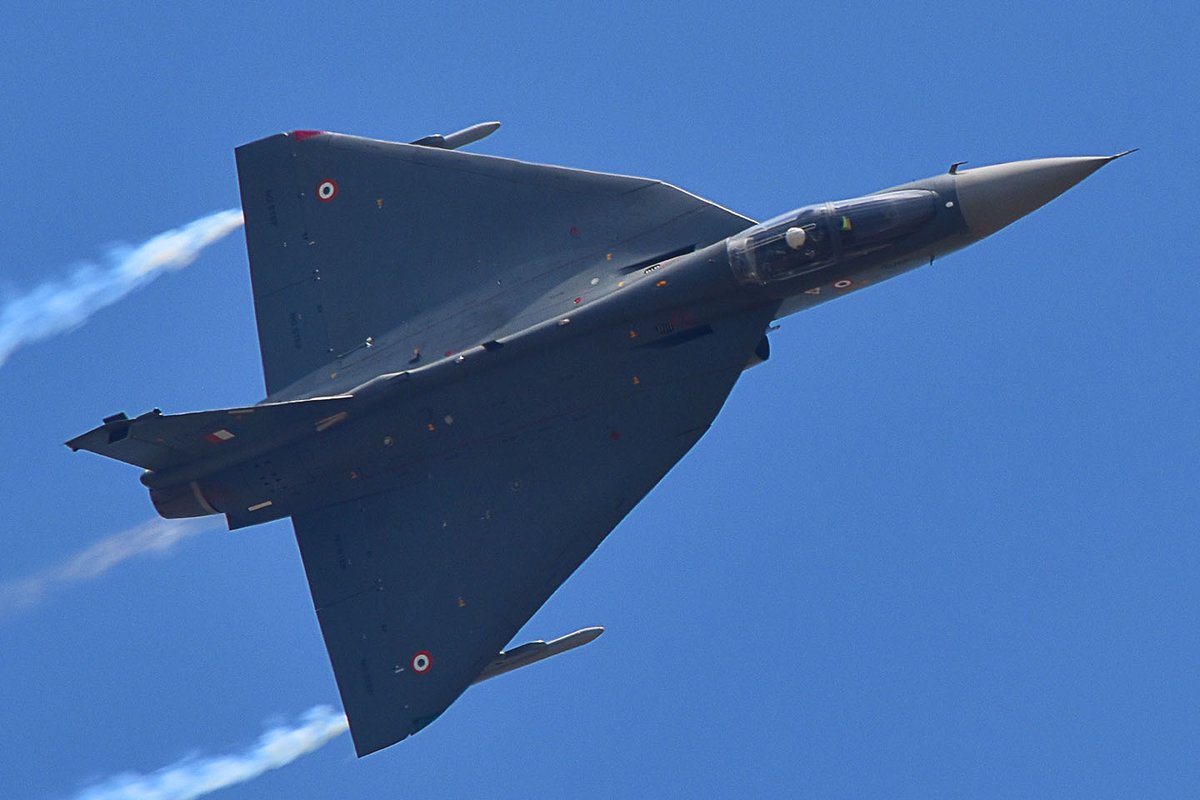Aerospace
Tejas Mark 2 is been approved for manufacturing : GOI
India has secured government sanctions and funds totaling Rs 10,000 crores of rupees ( $1,256 billion ) to move forward with the development of fighter jets.

India has secured government sanctions and funds totaling Rs 10,000 crores of rupees ( $1,256 billion ) to move forward with the development of fighter jets. The financing to launch the anticipated Tejas mark2 project, an updated version of the previous version of a fighter jet, has been eagerly anticipated for a long time.
The Tejas Mark-2 development project, which will cost over Rs 10,000 crore, was approved by the Cabinet Committee on Security (CCS).
In the next months, CCS will also approve the necessary financing for the development of AMCA aircraft, which is anticipated to cost over 15,000 crores.
Tejas Mark 2 will feature GE 414 engines and be able to produce up to 98 kilonewtons of thrust class. Compared to Tejas Mark 1, it will be able to engage in longer battles and carry more weapons.
Tejas Mark 1 will take the role of the antiquated Mig 21, often known as the “flying coffin,” which has earned a terrible reputation due to several crashes. The combat fleet of the IAF will also include successful jets like the Mirage 2000, Jaguar, and MiG 29.
The Mark 2 fighter’s medium weight will be employed for powerful standoff weapons, whereas the Tejas Mark 1 is primarily used for air defense.
Out of the 123 aircraft that the IAF has previously ordered, 30 are already in service with the defense fleet. By 2024 and beyond, an additional 73 enhanced Mark1A fighters and 10 trainers will be supplied. With the aid of DRDO and the Aeronautical Development Agency, the Tejas Mark 2 is expected to make its first flight in two to three years and start manufacturing by the year 2030.
The IAF urgently needs Tejas jets to increase the size of its fighter squadrons, which are currently only 32 but at least 42 are needed to counter the “collusive threat” from China and Pakistan.
As of right present, the IAF only has 32 aircraft, but it still needs 10 more to prepare a defensive reaction for the borders with China and Pakistan. A different advanced stealth fighter, weighing an additional 25 tonnes, is expected to enter production only by 2035.
With a 110 Kilonewton engine needed for AMCA, which is far more powerful, India is currently looking into co-development opportunities with businesses like the French Safran Group.
Modern stealth capabilities in the swing role The AMCA will include radar-absorbing materials and conformal antenna in addition to a “serpentine air-intake” and an interior bay for smart weaponry.

Aerospace
Boeing Transfers Rocket Stage to NASA, Paving Way for Human Moon Mission

Boeing has achieved a significant milestone by providing NASA with the second core stage of the Space Launch System (SLS) rocket.
This crucial component, crafted at NASA’s Michoud Assembly Facility (MAF), is set to propel the Artemis II crew into lunar orbit, marking humanity’s return to deep space after a 50-year hiatus.
The monumental Boeing-built rocket stage, the largest element of the Artemis II mission, will embark on a journey aboard the Pegasus barge, traveling 900 miles to NASA’s Kennedy Space Center.
Comparison of two legendary aircraft B777x vs B747 aircraft:Click here
Upon arrival, it will be meticulously integrated with other essential Artemis II components, including the upper stage, solid rocket boosters, and NASA’s Orion spacecraft within the iconic Vehicle Assembly Building. This intricate integration process is a vital step toward the eagerly anticipated Artemis II launch, slated for 2025.
“Boeing-built products helped land humankind on the moon in 1969, and we’re proud to continue that legacy through the Artemis generation,” remarked Dave Dutcher, vice president and program manager for Boeing’s SLS program. “Together, with NASA and our industry partners and suppliers, we are building the world’s most capable rocket and paving the way to deep space through America’s rocket factory in New Orleans.”
NASA, Lockheed Martin Reveal X-59 Quiet Supersonic Aircraft:Click here
The delivery of Core Stage 2 marks a significant achievement in the evolution of the SLS rocket. Towering over 200 feet and powered by four RS-25 engines, this core stage, coupled with two solid-fueled booster rockets, will generate a staggering 8.8 million pounds of thrust. This immense power is crucial to launching Artemis II and future missions into the vast expanse of space.
The SLS rocket stands unparalleled in its capability to transport both crew and substantial cargo to the moon and beyond in a single launch. Its extraordinary capacity will facilitate the delivery of human-rated spacecraft, habitats, and scientific missions to destinations including the moon and Mars, ushering in a new era of space exploration.
-

 Travel1 week ago
Travel1 week agoAir India to Expand US Operations with Three New Routes After a Decade
-

 Travel2 weeks ago
Travel2 weeks agoWhy We Should Avoid These Stamps in a Passport
-

 Airlines1 month ago
Airlines1 month agoInvestigations Reveal Fake Chinese Titanium in Boeing and Airbus Jets
-

 Tech4 weeks ago
Tech4 weeks agoChina’s CATL Plans 1,800-Mile Electric Plane Launch by 2027
-

 Airport3 days ago
Airport3 days agoTop 10 Largest Airports in the World by Size
-

 Aerospace4 weeks ago
Aerospace4 weeks agoChina’s Fighter Jets Turn Wings into Autonomous Drones
-

 Airlines4 days ago
Airlines4 days agoAir India Rolls Out A350s for Delhi-New York JFK and Newark Routes
-

 Defence3 weeks ago
Defence3 weeks agoBoeing Enhances Chinook with New Engines and Block II Upgrades at $96 Million







